About the Löwchen Breed
About the Name
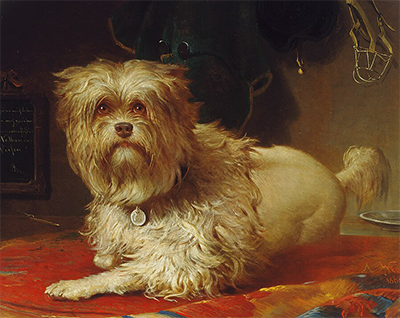 "Pes" Anton Karinger (Slovene, 1829-1870)The earliest recorded name of this breed is actually the Maltese Lion Dog and it kept this name until the French naturalist, Buffon renamed it Bichon Petit Chien Lion (Little Lion Dog) and the French have since claimed country of Origin status. Other names the breed has gone by are Schoshundle, Gutchen Hund and today’s name Lowchen, (little lion in German).
"Pes" Anton Karinger (Slovene, 1829-1870)The earliest recorded name of this breed is actually the Maltese Lion Dog and it kept this name until the French naturalist, Buffon renamed it Bichon Petit Chien Lion (Little Lion Dog) and the French have since claimed country of Origin status. Other names the breed has gone by are Schoshundle, Gutchen Hund and today’s name Lowchen, (little lion in German).
Products of the Renaissance, a period when symbolism was rife, the little lion dogs represented courage. Legend has it that knights who were killed in battle were buried with the statue of a lion at their feet, but if they died of natural causes the statue of a lion dog was substitute. Löwchen, whose name comes from the German words meaning “little lion,” were also popular as footwarmers and comforters.
History of the Breed
The history of the Lion is somewhat of a sordid affair. While there are bits and pieces of Löwchen-like dogs scattered throughout art from the 1400’s, documented pedigrees are a new world practice. Putting together the puzzle of breed histories is no easy task with many other breeds claiming to be the foundation of the Löwchen and the other way around. Several countries also boldly defend their stake in the origin of the breed. The only thing that is certain is that there isn’t consensus on the breed history until the time when Madame Bernert began her quest to bring the breed back from the brink of extinction in the 1940’s. It was then that documentation of the breed lineage began.
-------------------------
The Löwchen has a long history as a companion dog, particularly favored by aristocracy and royalty.
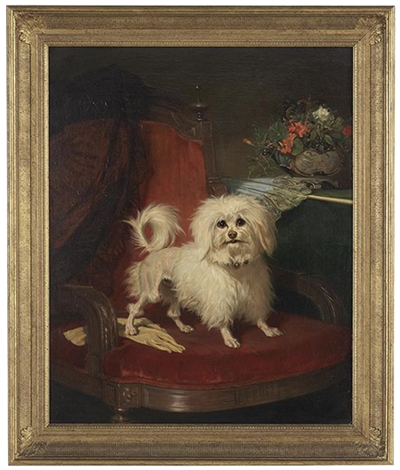 "Waiting for Mistress" Conradyn Cunaeus, (Dutch, 1828-1895), The Löwchen as a breed has a long and somewhat controversial history. We know from works of art depicting images of small dogs in a very distinctive lion trim that the breed dates to the 16th century. The breed is depicted throughout the centuries in paintings, block prints, line drawings and tapestries from around the world.
"Waiting for Mistress" Conradyn Cunaeus, (Dutch, 1828-1895), The Löwchen as a breed has a long and somewhat controversial history. We know from works of art depicting images of small dogs in a very distinctive lion trim that the breed dates to the 16th century. The breed is depicted throughout the centuries in paintings, block prints, line drawings and tapestries from around the world.
The controversy arises as to the exact origin of the breed. There are several theories on this debate, depending on who is doing the talking. One theory holds that the breed originated in the area of Northern Europe now known as Germany, France and Belgium. In this area the Löwchen is thought to be tied to the breeds that were the forerunner of the modern day poodle, and quite possibly as a factor in the development of the Toy Poodle.
Another line of thinking holds that the Löwchen originated in the Mediterranean region and are directly related to the Bichon type breeds of that area. The Löwchen has also been set in Russia and even the region that is now Tibet. Whatever ones view of the origin of the Löwchen, we know that the breed has survived through the great upheavals of hundreds of years to emerge very nearly as they appear in the art that is the documentation of their history.
The Löwchen has been the resident of all manner of households through the ages, from castles to the most ordinary farmyards and cottages. Aside from their primary function as a companion they were most likely great varmint hunters and fierce little guards of beloved hearth and home.
Folk tales surround the Löwchen, bringing a charming side to their history. It is said that the Löwchen was a favorite of castle ladies as a sort of living hot water bottle. The trimmed area would go under the covers for warmth and the furry part would attract the fleas out of the beds and away from the people. Another legend associated with the breed was that if a knight died in battle a lion was carved at the foot of his tomb, if he died at home in bed, a Löwchen was carved on his tomb.
The Legend of Bijou
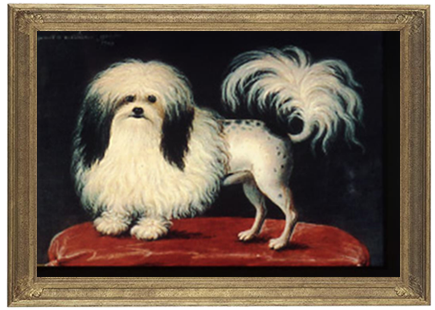 In the late 1700’s, Bijou, a parti-colored Löwchen lived in a castle in Weilburg, Germany on the Lahn River.
In the late 1700’s, Bijou, a parti-colored Löwchen lived in a castle in Weilburg, Germany on the Lahn River.
The story goes that, Bijou, through extreme loyalty to his beloved master, jumped from a window 60 feet above the river rather than be left behind when his master went off on a hunt. The ending of the story is the stuff of legend. One ending says that Bijou survived the jump and was rewarded by riding to the hunt on his master’s saddle, the other that the jump ended in disaster. Whichever ending is true, Bijou became famous. His life size portrait completed in 1787 still hangs in the baroness’s bedroom in Weilburg Castle. Bijou’s devotion, loyalty and fearlessness are very much evident in the Löwchen of today.
The Early Years
Little is written about the Löwchen during the early years. The first record of a breeder and fancier was a Dr. Walthier in the early 1800’s in Germany. The first know Löwchen standard was published in a book by Count Henry de Bylart, Dogs of All Nations. Maximillian de Conick was the first documented modern breeder and exhibitor of Löwchen. In 1897 he sold Madame Madelaine Bennert her first Löwchen. Madame Bennert would become recognized world wide for her efforts to save the rapidly disappearing breed.
The Why of the Lion Cut
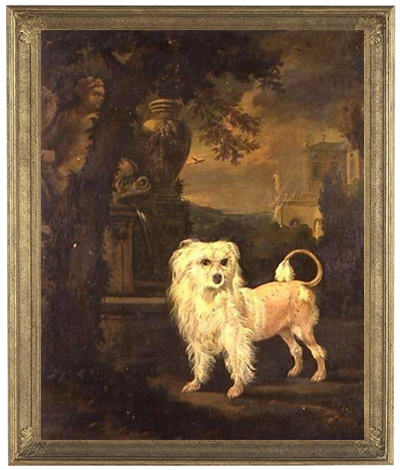 “Löwchen By A Fountain,” Jan Wyck, (Dutch, 1645-1702)The Löwchen breed’s trademark lion cut wasn’t entirely a whimsical fancy of bored noblewomen of pre-Renaissance Europe. The dog acted as a living hot water bottle. Its trimmed bottom half was slipped under the blankets for warmth, while the hairy upper body attracted fleas out of the bed and away from the sleeper. More pragmatic opinions say it was done as a sanitary measure to prevent matting and infestation.
“Löwchen By A Fountain,” Jan Wyck, (Dutch, 1645-1702)The Löwchen breed’s trademark lion cut wasn’t entirely a whimsical fancy of bored noblewomen of pre-Renaissance Europe. The dog acted as a living hot water bottle. Its trimmed bottom half was slipped under the blankets for warmth, while the hairy upper body attracted fleas out of the bed and away from the sleeper. More pragmatic opinions say it was done as a sanitary measure to prevent matting and infestation.
We love a good controversy as much as the next person, and the Lowchen has a couple of them swirling around its exact origins. One theory maintains that Lowchens originated in what is now Germany, France and Belgium with connections to breeds that may have been early progenitors of the poodle (if not an actual player in the development of the Toy Poodle).
Another theory holds that the Löwchen has its origins in the Mediterranean area and is directly related to Bichon type breeds. A third conjecture is that the Löwchen is from Russia, and even from Tibet. We’re holding out for a fourth theory that makes them extraterrestrials. If we’re to believe Lowchen owners, this would suddenly make sense of a lot of things (grin).
It makes us wish we could time travel back in time to pre-Renaissance Europe with a few of these naysayers, and visit that moment when one lady of the court said to another, “I know. Let’s shave the hair off this dog’s butt and groom him to look like a lion!”
While the lion cut is the trademark style of the Löwchen, it’s not necessary to have your dog in the lion cut unless you plan on showing your dog.
Madame Bennert's Mission
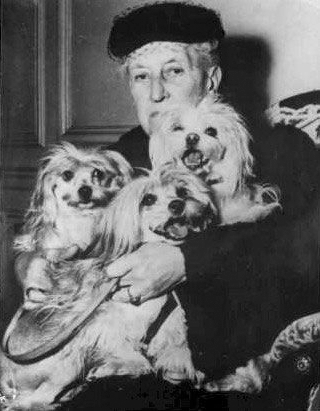 Madame Bennert with three LöwchensOver the years, however, the Löwchen’s popularity waned: by World War II, the breed was considered rare. A Belgian woman, Madame Bennert, who had owned Löwchen since 1897, made it her mission to prevent the breed from disappearing. “After a long and disappointing search,” she wrote, “I finally found two wonderful females. One was a blue and came from Lille, arid the other was biscuit-colored and came from the area of Dieghem. After a long search, I finally found a blue male, and this was the beginning of my small dog kennel.’’
Madame Bennert with three LöwchensOver the years, however, the Löwchen’s popularity waned: by World War II, the breed was considered rare. A Belgian woman, Madame Bennert, who had owned Löwchen since 1897, made it her mission to prevent the breed from disappearing. “After a long and disappointing search,” she wrote, “I finally found two wonderful females. One was a blue and came from Lille, arid the other was biscuit-colored and came from the area of Dieghem. After a long search, I finally found a blue male, and this was the beginning of my small dog kennel.’’
Bennert’s effort was successful, and for many years she worked closely with German breeders to increase the Löwchen’s numbers and maintain its quality. From her hands the breed passed on to German veterinarian Dr. Hans Rickert. It was from Von den Drei (VD3 Lowen) that Lowchen slowly began to spread worldwide and all Lowchen living today can trace their roots to his dogs.
English breeders began importing the dogs in 1968; it was three Löwchen from an English kennel that first came to the United States in 1971, imported by Charles and Jane Cook and in 1976 they were imported into Canada and Australia. The breed was officially recognized in Canada in 1995.
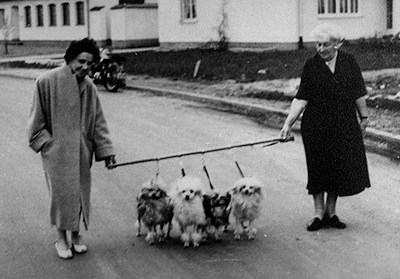 Madame Bennert walking her Löwchen
Madame Bennert walking her Löwchen
Modern Breed Standard
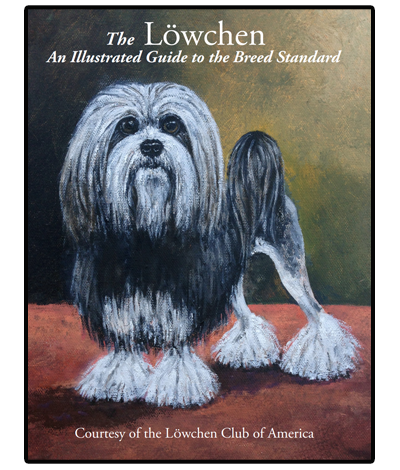 The Löwchen Club of America is pleased to present “The Löwchen, An Illustrated Guide to the Breed Standard.” This publication is intended as an educational supplement for breeders, exhibitors and fanciers of the breed, although it is primarily a guide for conformation judges. In recognition of the need to provide a comprehensive guide, the LCA has endeavored to gather together illustrations and breed-specific information in an effort to bring the words of the breed standard to life.
The Löwchen Club of America is pleased to present “The Löwchen, An Illustrated Guide to the Breed Standard.” This publication is intended as an educational supplement for breeders, exhibitors and fanciers of the breed, although it is primarily a guide for conformation judges. In recognition of the need to provide a comprehensive guide, the LCA has endeavored to gather together illustrations and breed-specific information in an effort to bring the words of the breed standard to life.
General Breed Characteristics
Appearance
Temperment
Löwchens are known for being affectionate, playful, and intelligent companion dogs. They are generally good with families and other pets, though they can be independent. They are also alert, making them good watchdogs, and can be prone to barking.
Health and Care:
They are generally considered a healthy breed with a lifespan of 13 to 15 years. Common health concerns include hip dysplasia, luxating patella, and certain eye conditions like progressive retinal atrophy. Their coat, despite its length, is relatively easy to care for, and they are considered non-shedding and low-dander, making them suitable for individuals with allergies. They require moderate exercise and enjoy spending time with their families.
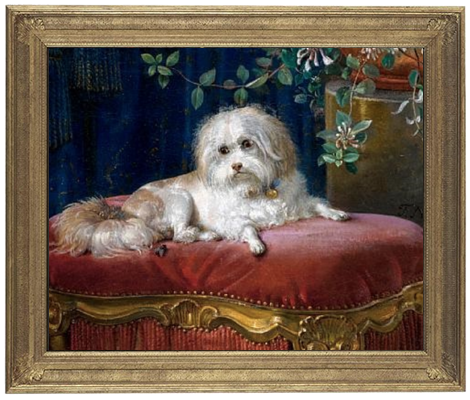 "Le Petit Chien de Lion" Friedrich von Nerly (German, 1872)Source Citations
"Le Petit Chien de Lion" Friedrich von Nerly (German, 1872)Source Citations
- https://www.akc.org/expert-advice/dog-breeds/lowchen-history/